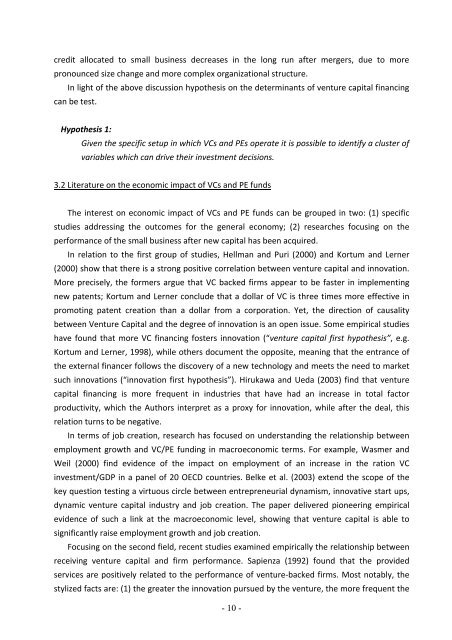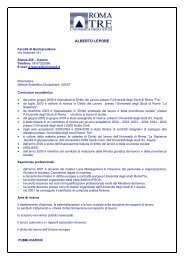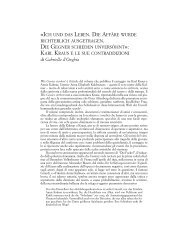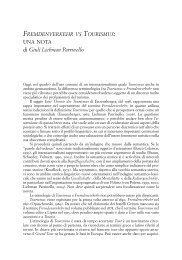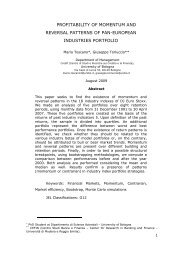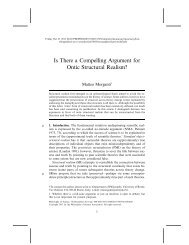Determinants and effects of Venture Capital and Private Equity ...
Determinants and effects of Venture Capital and Private Equity ...
Determinants and effects of Venture Capital and Private Equity ...
Create successful ePaper yourself
Turn your PDF publications into a flip-book with our unique Google optimized e-Paper software.
credit allocated to small business decreases in the long run after mergers, due to more<br />
pronounced size change <strong>and</strong> more complex organizational structure.<br />
In light <strong>of</strong> the above discussion hypothesis on the determinants <strong>of</strong> venture capital financing<br />
can be test.<br />
Hypothesis 1:<br />
Given the specific setup in which VCs <strong>and</strong> PEs operate it is possible to identify a cluster <strong>of</strong><br />
variables which can drive their investment decisions.<br />
3.2 Literature on the economic impact <strong>of</strong> VCs <strong>and</strong> PE funds<br />
The interest on economic impact <strong>of</strong> VCs <strong>and</strong> PE funds can be grouped in two: (1) specific<br />
studies addressing the outcomes for the general economy; (2) researches focusing on the<br />
performance <strong>of</strong> the small business after new capital has been acquired.<br />
In relation to the first group <strong>of</strong> studies, Hellman <strong>and</strong> Puri (2000) <strong>and</strong> Kortum <strong>and</strong> Lerner<br />
(2000) show that there is a strong positive correlation between venture capital <strong>and</strong> innovation.<br />
More precisely, the formers argue that VC backed firms appear to be faster in implementing<br />
new patents; Kortum <strong>and</strong> Lerner conclude that a dollar <strong>of</strong> VC is three times more effective in<br />
promoting patent creation than a dollar from a corporation. Yet, the direction <strong>of</strong> causality<br />
between <strong>Venture</strong> <strong>Capital</strong> <strong>and</strong> the degree <strong>of</strong> innovation is an open issue. Some empirical studies<br />
have found that more VC financing fosters innovation (“venture capital first hypothesis”, e.g.<br />
Kortum <strong>and</strong> Lerner, 1998), while others document the opposite, meaning that the entrance <strong>of</strong><br />
the external financer follows the discovery <strong>of</strong> a new technology <strong>and</strong> meets the need to market<br />
such innovations (“innovation first hypothesis”). Hirukawa <strong>and</strong> Ueda (2003) find that venture<br />
capital financing is more frequent in industries that have had an increase in total factor<br />
productivity, which the Authors interpret as a proxy for innovation, while after the deal, this<br />
relation turns to be negative.<br />
In terms <strong>of</strong> job creation, research has focused on underst<strong>and</strong>ing the relationship between<br />
employment growth <strong>and</strong> VC/PE funding in macroeconomic terms. For example, Wasmer <strong>and</strong><br />
Weil (2000) find evidence <strong>of</strong> the impact on employment <strong>of</strong> an increase in the ration VC<br />
investment/GDP in a panel <strong>of</strong> 20 OECD countries. Belke et al. (2003) extend the scope <strong>of</strong> the<br />
key question testing a virtuous circle between entrepreneurial dynamism, innovative start ups,<br />
dynamic venture capital industry <strong>and</strong> job creation. The paper delivered pioneering empirical<br />
evidence <strong>of</strong> such a link at the macroeconomic level, showing that venture capital is able to<br />
significantly raise employment growth <strong>and</strong> job creation.<br />
Focusing on the second field, recent studies examined empirically the relationship between<br />
receiving venture capital <strong>and</strong> firm performance. Sapienza (1992) found that the provided<br />
services are positively related to the performance <strong>of</strong> venture‐backed firms. Most notably, the<br />
stylized facts are: (1) the greater the innovation pursued by the venture, the more frequent the<br />
- 10 -


